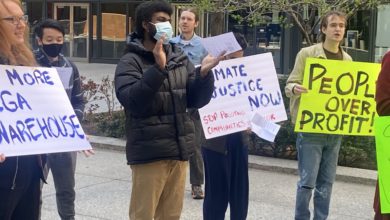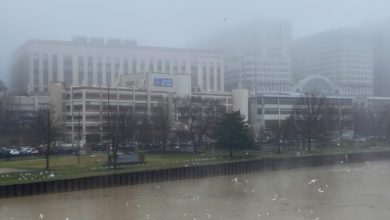Originally posted Nov. 12, 2013
“When will they ever learn?” This is the question that concerned environmentalist and political analysts are asking in the wake of the terrible “super typhoon” nicknamed “Haiyan” or “Yolanda” that hit the Central Philippines, most specifically the central islands of the Visayas and other adjoining islands on November 9.
It is imperative that the government authorities in the Philippines alleviate the plight of the Filipino people and focus on protecting the archipelago from natural tragedies by proactive means.
In the case of the Philippines, hundreds of years of destructive mining and logging, destructive agri-business and uncalled for development projects like turning pristine beaches and lands into eco-tourist resorts and large reclamations areas that destroy nature, have gone unabated.
And when nature has fought back, we see the devastation it has caused in eco-tourism areas like Bohol and Cebu, and the logged-over areas of Samar and Leyte, the most hard hit by the super typhoon Yolanda that has killed more than 10,000 people in the Central Visayas.
This disaster was caused by what the Philippine government has called a “storm surge:” a type of tidal wave carried by the winds of the typhoon that comes in successive waves as high as two story or 30 feet, more destructive than a tsunami. The storm surge leveled the whole city of Tacloban, Leyte and other cities on its path of destruction.
Safeguard the environment and alleviate people’s suffering
Time and time again, the Philippine government has failed to protect the people from natural and man-made disasters. Instead, the government has prolonged the agony of the people by failing to deliver basic services to the victims of natural disasters.
The recent typhoon has proven this fact again. The Storm Ondoy in 2009, the Storm Pablo that hit Southeastern Mindanao, the successive rains of Habagat and recent storms of 2013 and the Oct. 15 earthquake in the Visayas of the Central Philippines are just examples of the reactive response and not proactive actions of Philippine authorities.
Now, even when President Aquino has promised to improve the government response, much is still to be desired with regards to disaster prevention and alleviation.
Historical legacy of colonial plunder of the Philippines
Samar, Leyte and Cebu, when they were colonized by the Spaniards, became the source of wood to make ships known as galleons that were used for commercial trading between the Philippines and Mexico for more than 250 years. The Acapulco-Manila trade ceased in 1821 when Mexico gained its liberation and independence from Spain.
As a consequence, forests were destroyed for ship building and for widespread construction of forts and churches for Spanish use. This trend did not change when the U.S. occupied the Philippines at the turn of the 20th century.
We remember that Samar and Leyte were turned into “a howling wilderness” when U.S. General Jacob Smith ordered a ‘scorched-earth policy” in Samar to subdue the Filipino revolution from 1899-1916.
Logging and commercial mining were introduced by the U.S. and went on even after the the Philippines’ nominal independence in 1946. In fact during the Marcos dictatorship, the Defense Minister Juan Ponce-Enrile made Samar and Leyte his logging empire.
Thus, the two islands on the typhoon path became more vulnerable to storms’ death and destruction every year. At least 24 typhoons a year passed through these islands.
The people’s demands for tragedy alleviation
The Filipino people still hope that current President Benigno Aquino III translates into actions his promise to make the Philippines a better place to live in so that no more Filipinos will be a slave in another land and the 12 million overseas Filipino workers can go home to a better homeland.
We in the Alliance-Philippines demand that the Philippine government do the following:
Implement a total logging ban all over the Philippines and conduct widespread reforestation to counter the rampant deforestation in the country. There is an immediate need to save the last remaining 30 percent of our forest cover and launch a nation-wide reforestation drive.
The Department of Environment and Natural Resources must see to it that this law is implemented so that legal and illegal logging are stopped in Mindanao and all the watershed areas of our country.
Stop destructive extractive mining all over the Philippines especially in Zambales where the Chinese mining corporations are destroying the mountains and have caused so many floods; in Cagayan where the Chinese are also mining “Black Sand along the Cagayan River, coal mining in Zinandungan Valley and Isabela and other areas.
Remember what happened in Marinduque, Leyte and in Surigao. Ending destructive mining will eventually stop the degradation and denudation of our mountains and prevent landslides. We should cater first to the needs of the Filipino people and not of the foreign corporations.
Stop the reclamation projects in Manila Bay, relocate all low-lying coastal areas and cities and settlers along the riverbanks and major waterways of major cities and towns.
There is a need to implement good and proper urban planning. Provide decent and proper housing to the people who will be relocated along Laguna Lake and major waterways.
Train and educate the masses in disaster preparedness. Provide early warning systems along waterways all over the country and build more ready-made shelters so they will not use the schools for emergencies and disasters.
But all of these efforts are only palliatives for we know that the government is not serious about reforming the system. It is always the right of the Filipino people to fight and advocate for a real thoroughgoing change in the rotten system.
Only through a true national and social liberation struggle can the Filipino people defend and nurture the environment and protect its resources and benefits for the people. Only systemic change can improve the lives of the people.
Call for solidarity
More than 2 million people have been affected by Typhoon Yolanda. To ensure that the survivors of in the Visayas receive the immediate help that they need, the Filipino American Community of Los Angeles and the United States Action against PDAF (USAP Coalition) has initiated the TAWID BAHA Disaster Relief Drive for the Visayas and is accepting monetary donations (no in-kind donations please). All monetary donations will go towards helping the more than 2 million affected communities in the Visayas hard hit by Tyhpoon Yolanda and the cost of wiring the donations. Donations of any amount are tax-deductible.
Donate through FACLA TAWID BAHA Disaster Relief Drive
Send a check to: Filipino American Community of Los Angeles (FACLA) 1740 W.Temple St. Los Angeles CA, 90026
For more information please call FACLA at (213) 484-1527 or USAP at (213)241-0995.
*For Immediate Release*
*People’s CORE*
*November 22, 2013*
*PEOPLE’S CORE LAUNCHES SAGIP TULUY-TULOY TULONG PILIPINAS (STP), 2013*
*Los Angeles–*The Los Angeles-based non-profit organization, People’s Community Organization for Reform and Empowerment (People’s CORE) along with the Alliance Philippines (AJLPP) ,Justice for Filipino American Veterans (JFAV), KmB / Pro-People Youth, and The Park’s Finest are calling on the community to respond to the recent tragedy in the Philippines caused by Typhoon Haiyan/Yolanda, the strongest typhoon ever recorded to hit land.
Reports indicate that 5, 200 Filipinos have lost their lives and over 43 provinces in the Visayas have been affected, with Tacloban City now in ruins as the hardest hit. Haiyan is estimated to have destroyed 90% percent of structures in its path as it tore into the coastal provinces of Leyte and Samar. Overall, reports estimate that 11 million people have been affected.
*The STP Relief Drive 2013 is collecting both monetary and material





